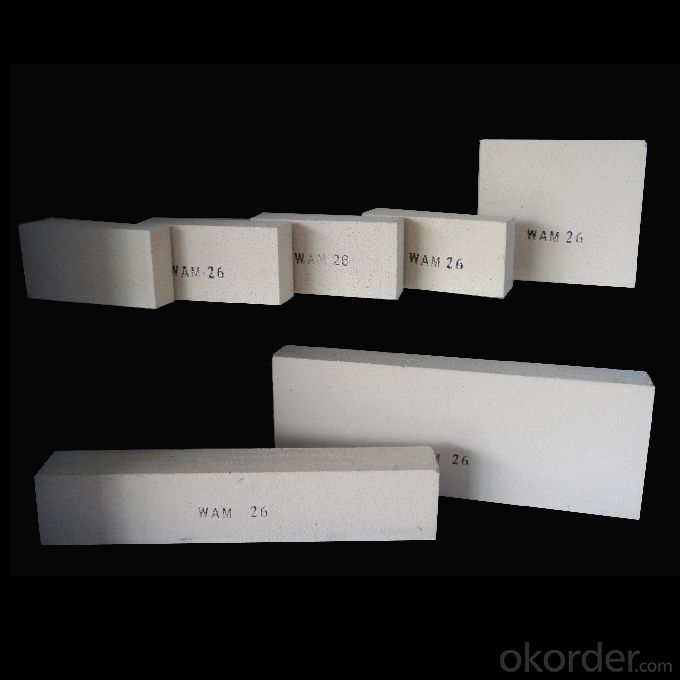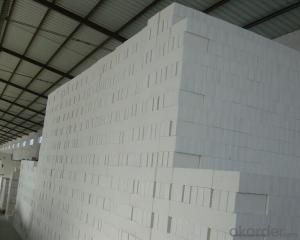Refractory Mullite Insulating Fire Brick GJM26
- Loading Port:
- Shanghai
- Payment Terms:
- TT OR LC
- Min Order Qty:
- 20 m.t.
- Supply Capability:
- 100000 m.t./month
OKorder Service Pledge
OKorder Financial Service
You Might Also Like
General Information
CMAX insulating firebricks are classified under temperature between 1300℃ to 1700℃, manufactured from high purity alumina clay.
1. Lower content of iron, alkaline and impurities, good high temperature properties.
2. Homogeneous structure, light weight, energy saving because lower heat storage in the furnace during cooling cycles.
3. High strength, good thermal shock resistance under high temperature.
4. Precise sizes due to grinding and shaping after sintering, which meets the requirement of construction.
5. Max service temp: Up to 1730C (3160F)
Feature
Light weight and low thermal conductivity
Low heat storage
Low iron and impurities
High thermal shock resistance
Application
CMAX insulating firebricks can be used as a hot face lining directly exposed to the heat or as a backup insulation layer in iron and steel mills, non-ferrous foundries, petrochemical, ceramic, glass.
ITEM | GJM30 | GJM28 | GJM26 | GJM23 |
Classification Temperature, ℉/℃ | 3000/1650 | 2800/1540 | 2600/1430 | 2300/1260 |
Bulk Density,g/cm³ | ≤1.0 | ≤0.9 | ≤0.8 | ≥0.5 |
Reheating Linear Change, % | ≤0.9 (1550℃,12 h) | ≤0.8 (1510℃,12 h) | ≤0.7 (1410℃,12 h) | ≤0.5 (1230℃,12 h) |
Al2O3 Content, % | ≥75 | ≥65 | ≥55 | ≥45 |
Fe2O3 Content, % | ≤0.5 | ≤0.6 | ≤0.7 | ≤1.0 |
Thermal Conductivity: | ||||
800℃, w/m.k | ≤0.39 | ≤0.37 | ≤0.35 | ≤0.18 |
1000℃, w/m.k | ≤0.43 | ≤0.41 | ≤0.39 | ≤0.20 |
1200℃, w/m.k | ≤0.48 | ≤0.46 | ≤0.43 | --- |

- Q:Are insulating fire bricks lightweight or heavy?
- Insulating fire bricks are lightweight.
- Q:Are insulating fire bricks resistant to water absorption?
- Insulating fire bricks possess resistance against water absorption. Their design emphasizes low porosity and high density, effectively preventing water from penetrating their structure. This resistance to water absorption holds significance as water exposure can result in cracks or damage to fire bricks, thereby diminishing their insulation capabilities and lifespan. Consequently, insulating fire bricks emerge as an optimal selection for applications necessitating moisture resistance, including the construction of kilns, furnaces, or other environments characterized by high temperatures.
- Q:Do insulating fire bricks have a high resistance to spalling?
- Yes, insulating fire bricks have a high resistance to spalling. Spalling refers to the breaking off or flaking of the surface of a material, and in the case of fire bricks, it typically occurs due to high temperatures and thermal shock. Insulating fire bricks are specifically designed to withstand these extreme temperatures and thermal cycling, making them highly resistant to spalling. These bricks are made from high-quality refractory materials, such as alumina or silica, which have excellent thermal shock resistance. Additionally, they are manufactured with a low thermal conductivity, which helps to minimize heat transfer and reduce the risk of spalling. Overall, insulating fire bricks are an ideal choice for applications where high resistance to spalling is required, such as in furnaces, kilns, and other high-temperature environments.
- Q:Can insulating fire bricks be used in the construction of gas kilns?
- Yes, insulating fire bricks can be used in the construction of gas kilns. Insulating fire bricks are designed to have low thermal conductivity, which means they can help retain heat and improve energy efficiency in a kiln. Gas kilns require proper insulation to ensure that heat is evenly distributed and maintained within the kiln chamber. Insulating fire bricks can be used to line the walls, floor, and ceiling of the kiln, creating a barrier that helps to prevent heat loss and improve the kiln's performance. Additionally, insulating fire bricks are lightweight and easy to work with, making them a popular choice for kiln construction projects.
- Q:Can insulating fire bricks be used in high-temperature insulation for aerospace applications?
- Insulating fire bricks are capable of being utilized for high-temperature insulation in aerospace applications. Constructed from lightweight refractory materials possessing exceptional insulating properties, these bricks can endure extreme temperatures. The bricks possess a low thermal conductivity, effectively decreasing heat transfer and maintaining the desired temperature within aerospace components. Within the realm of aerospace applications, environments of elevated temperatures are commonly encountered, such as within rocket engines, exhaust systems, and thermal protection systems. Insulating fire bricks can be employed in these applications to furnish thermal insulation, shielding delicate components from excessive heat and averting heat loss to the surroundings. Furthermore, insulating fire bricks are renowned for their exceptional resistance to thermal shock, thereby enabling them to endure sudden temperature changes without cracking or deteriorating. This attribute is of utmost importance in aerospace applications, where components undergo substantial temperature variations during launch, re-entry, or other operational phases. Moreover, insulating fire bricks possess lightweight characteristics, which can prove advantageous in aerospace applications where weight reduction is crucial for fuel efficiency and overall performance. By implementing insulating fire bricks, aerospace engineers can achieve efficient thermal insulation while minimizing the added weight to the system. All in all, insulating fire bricks constitute a viable solution for high-temperature insulation in aerospace applications. Their exceptional insulating properties, resistance to thermal shock, and lightweight nature render them suitable for safeguarding critical aerospace components within environments of extreme temperatures.
- Q:Can insulating fire bricks be used for insulation in chemical plants?
- Yes, insulating fire bricks can be used for insulation in chemical plants. These bricks are made from lightweight materials with high insulating properties, such as ceramic fibers or refractory materials. They are designed to withstand high temperatures, making them suitable for use in environments with chemical processes that generate heat. Insulating fire bricks can be used in various applications within chemical plants, including lining for furnaces, reactors, kilns, and other equipment. Their excellent insulating properties help to reduce heat loss, conserve energy, and maintain optimal operating temperatures, ensuring the efficiency and safety of the chemical processes.
- Q:Do insulating fire bricks have a high resistance to spalling?
- Yes, insulating fire bricks have a high resistance to spalling.
- Q:Are insulating fire bricks resistant to alkali-silica reaction?
- Insulating fire bricks (IFBs) are not inherently resistant to alkali-silica reaction (ASR). ASR is a chemical reaction that occurs between the alkalis from cement and reactive forms of silica present in aggregates, which can lead to the formation of a gel that expands and causes cracking in concrete structures. While IFBs are generally made from refractory materials that are designed to withstand high temperatures and thermal shock, they do not have specific properties to resist ASR. The resistance to ASR depends on the composition and characteristics of the specific refractory material used in the IFB. If the refractory material used in the IFB contains reactive forms of silica, such as quartz or cristobalite, and there is exposure to alkalis, there is a possibility of ASR occurring. However, if the refractory material is low in reactive silica content or contains additives that can mitigate ASR, the risk of ASR may be minimized. It is important to note that the primary purpose of IFBs is to provide insulation in high-temperature applications, such as kilns, furnaces, and fireplaces. If ASR resistance is a critical requirement for a specific application, it is recommended to consult with the manufacturer or a materials engineer to determine the suitability of the IFB for that particular scenario.
- Q:What are the main properties of insulating fire bricks?
- IFBs, also known as insulating fire bricks, possess a variety of properties that make them perfect for different high-temperature uses. Firstly, their thermal insulation properties are excellent. They have a low thermal conductivity, meaning they effectively prevent heat transfer. This characteristic makes them ideal for environments where insulation is crucial, such as kilns, furnaces, and industrial ovens. The low thermal conductivity of IFBs helps to minimize heat loss and maintain high temperatures within these structures. Another important property of IFBs is their high refractoriness. They can endure extreme temperatures without losing their structural integrity. IFBs can withstand temperatures of up to 3000°F (1650°C), making them suitable for use in extremely hot environments. This high refractoriness allows them to be used in applications that involve the containment of molten metals, glass, or other materials at elevated temperatures. Furthermore, IFBs are lightweight and have a relatively low bulk density. This lightweight nature makes them easier to handle and install, reducing the labor and cost involved in construction or maintenance projects. The low bulk density of IFBs also contributes to their excellent thermal insulation properties as it reduces the number of air pockets within the material, thereby minimizing heat transfer. Additionally, IFBs have good chemical resistance. They are highly resistant to chemical attack from various substances, including acids, alkalis, and other corrosive agents. This property allows IFBs to maintain their structural integrity even in harsh chemical environments, making them suitable for applications in industries like chemical processing, metal refining, and incineration. Finally, IFBs are known for their durability and long lifespan. They have excellent mechanical strength and can withstand thermal cycling, meaning they can endure repeated exposure to extreme temperatures without cracking or breaking. This longevity makes them a cost-effective choice for applications where durability and reliability are paramount. In summary, the main properties of IFBs include excellent thermal insulation, high refractoriness, lightweight structure, good chemical resistance, and durability. These properties make IFBs suitable for a wide range of high-temperature applications, providing efficient insulation, protection against extreme temperatures, and long-lasting performance.
- Q:Do insulating fire bricks expand and contract with temperature changes?
- Insulating fire bricks do indeed undergo expansion and contraction in response to temperature variations. Similar to all other materials, exposure to heat causes these bricks to expand, whereas cooling leads to their contraction. This expansion and contraction phenomenon arises from the material's thermal expansion coefficient, which dictates the degree of expansion or contraction in relation to temperature changes. It is crucial to acknowledge this characteristic when utilizing insulating fire bricks in situations that involve anticipated temperature fluctuations. Neglecting to account for the expansion and contraction may result in structural harm or the formation of cracks.
1. Manufacturer Overview |
|
|---|---|
| Location | |
| Year Established | |
| Annual Output Value | |
| Main Markets | |
| Company Certifications | |
2. Manufacturer Certificates |
|
|---|---|
| a) Certification Name | |
| Range | |
| Reference | |
| Validity Period | |
3. Manufacturer Capability |
|
|---|---|
| a)Trade Capacity | |
| Nearest Port | |
| Export Percentage | |
| No.of Employees in Trade Department | |
| Language Spoken: | |
| b)Factory Information | |
| Factory Size: | |
| No. of Production Lines | |
| Contract Manufacturing | |
| Product Price Range | |
Send your message to us
Refractory Mullite Insulating Fire Brick GJM26
- Loading Port:
- Shanghai
- Payment Terms:
- TT OR LC
- Min Order Qty:
- 20 m.t.
- Supply Capability:
- 100000 m.t./month
OKorder Service Pledge
OKorder Financial Service
Similar products
New products
Hot products
Hot Searches
Related keywords
































